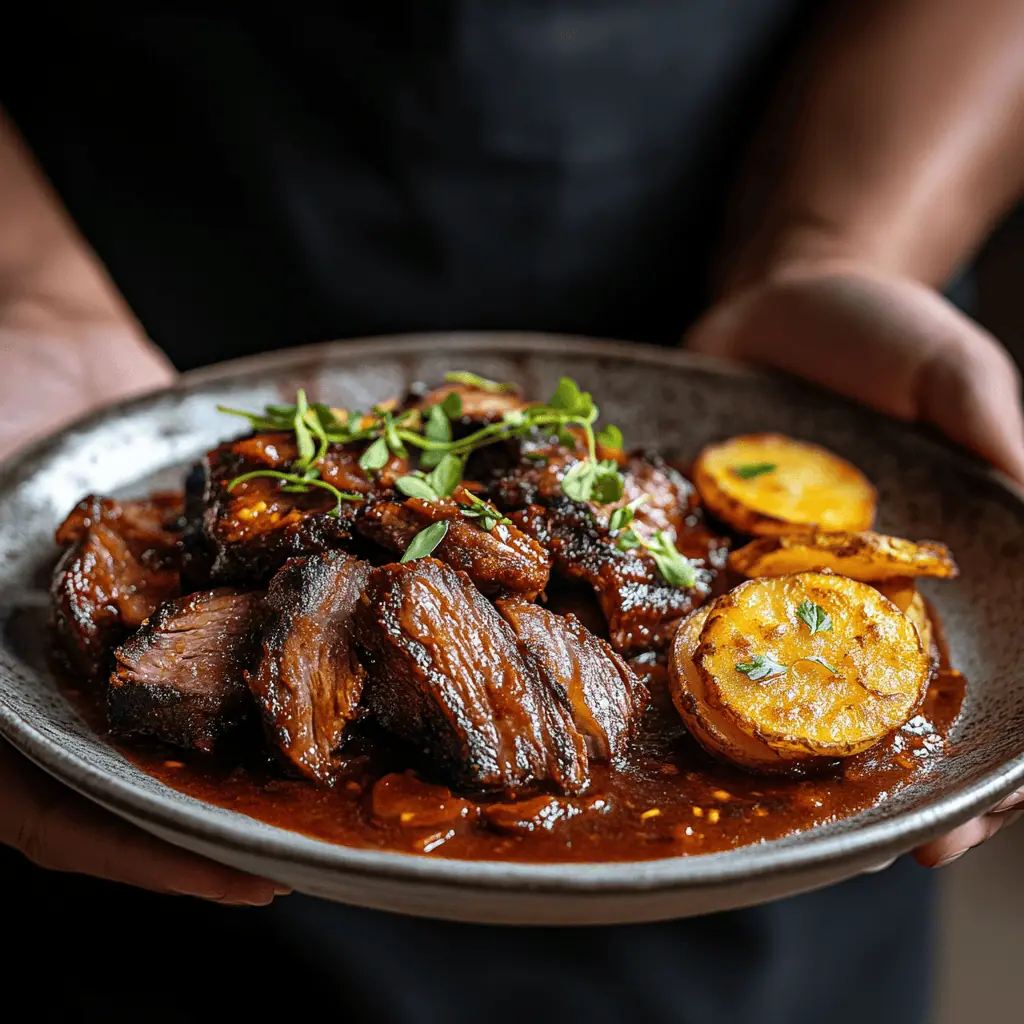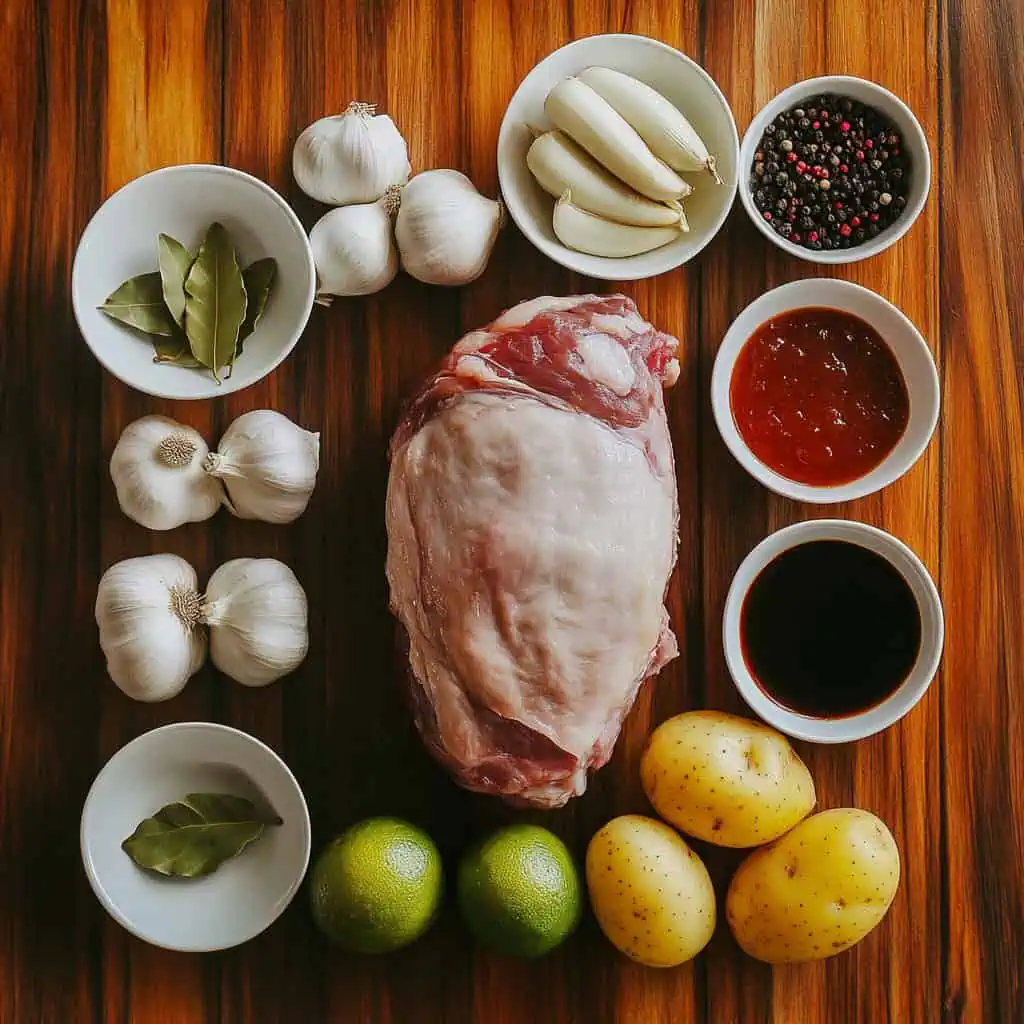As a food enthusiast who grew up in a Filipino household, I discovered this authentic Kapampangan Pork Asado recipe through my cousin, Alexandrea, a trained chef who honed her skills in Pampanga's finest kitchens.
What sets this traditional recipe apart from other versions is its perfect balance of tangy calamansi marinade and rich tomato-liver sauce, a signature combination that has made Pampanga the culinary capital of the Philippines.
After years of testing and refining this heritage recipe in my own kitchen, I'm sharing the exact techniques and tips that transform an ordinary pork dish into a memorable family meal.
This time-tested version of Kapampangan Pork Asado has earned its place as my most requested recipe, garnering praise from both home cooks and professional chefs alike. While the cooking process requires patience, particularly during the marination and braising stages, I've detailed every step to ensure your success.
This recipe delivers restaurant-quality results that showcase the depth and sophistication of authentic Filipino cuisine.
Jump to:

Why You'll Love This Recipe
- Perfect Balance of Flavors: The unique combination of tangy calamansi, savory soy sauce, and rich tomato-liver sauce creates an unforgettable taste that's distinctly Kapampangan
- Fall-Apart Tender: Our slow-braising technique ensures melt-in-your-mouth meat every time
- Make-Ahead Friendly: Actually tastes better the next day, perfect for special occasions
- Family-Tested: This recipe has been perfected through generations of Kapampangan cooking
- Restaurant-Quality: Master the techniques that make this dish a staple in Pampanga's finest restaurants
Ingredients
Each element in this recipe serves a specific purpose in creating the perfect Kapampangan Pork Asado. The pork shoulder's rich marbling ensures tenderness during slow cooking, while calamansi juice tenderizes the meat and adds brightness.
Soy sauce provides depth and umami, onions and garlic create an aromatic base, and the liver spread is the secret ingredient that gives the sauce its velvety texture and distinctive richness.
The potatoes not only absorb the flavorful sauce but also add heartiness, making this truly a complete meal that has stood the test of time in Filipino cuisine.

- 4 pounds whole pork shoulder (kasim)
- ½ cup calamansi juice
- ¼ cup soy sauce
- 1 large white onion, thinly sliced
- 4 cloves garlic, minced
- ¼ teaspoon cracked black peppercorns
- ¼ cup cooking oil
- 2 large potatoes, peeled and sliced ¼-inch thick
- 1 cup tomato sauce
- 1½ cups water
- 1 bay leaf
- 1 can (3 ounces) liver spread
- Salt and pepper to taste
- Optional: Kitchen twine for tying
Equipment
- Dutch Oven or Heavy-Bottomed Pot: Essential for even heat distribution during the braising process, ensuring your meat cooks uniformly and becomes perfectly tender
- Kitchen Twine: Used to tie the pork shoulder for even cooking and to help it maintain its shape
- Sharp Chef's Knife: For properly trimming the meat and slicing potatoes evenly
- Heavy Frying Pan: For achieving the perfect golden crust on your potatoes and a beautiful sear on the pork
- Meat Thermometer: To ensure your pork reaches the ideal temperature of 195°F (90°C) for that fall-apart tenderness
- Cutting Board: A sturdy board with a juice groove to catch drippings when slicing the finished pork
- Tongs: For safely flipping and handling the hot meat during the searing process
- Wooden Spoon: To gently stir the sauce without scratching your cookware
- Measuring Cups and Spoons: For precise ingredient measurements

How To Make
- Prepare the marinade: In a large bowl, combine calamansi juice, soy sauce, thinly sliced onions, minced garlic, and cracked peppercorns. Pat the pork shoulder dry and optionally tie with kitchen twine for even cooking. Place in the marinade, massage thoroughly, and refrigerate for 2-4 hours.
- Prepare the potatoes: While the meat marinates, heat oil in a large, heavy-bottomed pan and fry potato slices until golden brown. Remove and set aside.
- Sear the meat: Remove the pork from marinade, reserving the liquid and aromatics. Pat the meat dry and sear on all sides until well-browned in the same pan used for potatoes. Remove and set aside.
- Create the braising liquid: In the same pan, sauté the reserved onions and garlic from the marinade. Add the reserved marinade liquid, tomato sauce, water, and bay leaf. Return the pork to the pan and bring to a simmer. Cover and cook on low heat for 2-2.5 hours until fork-tender.
- Finish the sauce: Once the meat is tender, remove it from the pan. Stir liver spread into the sauce until well combined. Season with salt and pepper to taste. Let the meat rest for 15 minutes before slicing.
- Serve: Arrange the sliced meat and fried potatoes on a serving platter, then pour the hot sauce over everything. Serve with steaming white rice and garnish with fresh calamansi halves.

Tips from Lola's Kitchen
- Choose the right cut: Select pork shoulder with good marbling for the most flavorful and tender results
- Patience is key: Don't rush the marination or braising process—these steps develop the complex flavors that make this dish special
- Perfect sear: Make sure your pan is very hot before adding the meat, and don't crowd the pan—a proper sear creates the foundation for rich flavor
- Low and slow: Keep your braising temperature low and gentle to prevent the meat from becoming tough
- Rest before slicing: Allow the meat to rest for at least 15 minutes before slicing to keep the juices locked in
- Sauce thickness: If you prefer a thicker sauce, simmer it uncovered for 10-15 minutes after adding the liver spread
- Overnight magic: This dish tastes even better the next day, as the flavors have time to deepen and meld
Substitutions
- Pork Cut: While pork shoulder is traditional, you can use pork belly for a richer version or pork loin for a leaner option (reduce cooking time for pork loin)
- Calamansi Juice: If you can't find calamansi, use 6 tablespoons lemon juice mixed with 2 tablespoons orange juice
- Liver Spread: Substitute with 2 tablespoons tomato paste mixed with 2 tablespoons mashed cooked chicken liver
- Tomato Sauce: Use 4 fresh tomatoes (blanched, peeled, and pureed) plus 2 tablespoons tomato paste
- Soy Sauce: Coconut aminos or tamari can work for those with dietary restrictions
- Potatoes: Sweet potatoes offer a delicious alternative with a different flavor profile
Troubleshooting
- Tough meat: If your pork is still tough after the recommended cooking time, continue cooking on low heat for 30-minute increments until tender. Next time, ensure you're cooking at a very gentle simmer.
- Watery sauce: Remove the lid and simmer uncovered for 15-20 minutes to reduce and concentrate the flavors. In the future, measure liquids precisely.
- Too salty: Add quartered potatoes to the sauce while warm—they'll absorb excess salt. You can also add a small amount of sugar to balance the flavors.
- Dry meat: The meat was likely overcooked at too high a temperature. Next time, keep the heat lower and check for tenderness earlier.
- Curdled sauce: If your sauce looks separated, whisk in 1 tablespoon of flour mixed with 2 tablespoons water and simmer gently to rebind.
Storage & Reheating
- Refrigeration: Store in an airtight container for 3-4 days. For best results, store the meat and sauce separately.
- Freezing: Freeze in portion-sized containers for up to 3 months. Thaw overnight in the refrigerator before reheating.
- Reheating on Stovetop: Place in a covered pan with 2-3 tablespoons of water and heat gently until warmed through (165°F).
- Reheating in Microwave: Use 70% power, cover with a microwave-safe lid, and heat in 1-minute intervals, stirring between each, until thoroughly heated.
- Freshening Up: Add a squeeze of fresh calamansi juice and a sprinkle of chopped parsley when serving reheated asado to brighten the flavors.

FAQ
Can I make this in a slow cooker?
Absolutely! First, sear the meat as directed, then transfer to a slow cooker with all remaining ingredients. Cook on low for 8 hours or high for 4-6 hours until fork-tender.
Why is my sauce splitting?
This typically happens with too high heat or rapid boiling. Keep it at a gentle simmer and stir occasionally. If it splits, whisk vigorously while adding 1-2 tablespoons of water.
Can I skip the liver spread?
You can, but it adds significant richness and helps thicken the sauce. If omitting, consider adding 2 tablespoons of tomato paste mixed with 1 tablespoon flour to maintain texture and depth.
What's the best cut of pork to use?
Pork shoulder (kasim) is ideal for its fat content and texture when braised. The marbling melts during cooking, resulting in incredibly tender meat.
How do I know when the pork is perfectly done?
The meat should easily pull apart with a fork. For precision, use a meat thermometer—the internal temperature should read around 195°F (90°C) for that fall-apart texture.
Can I add vegetables to this dish?
Yes! Bell peppers, carrots, and mushrooms make excellent additions. Add firm vegetables during the last 45 minutes of braising time.
Is this dish spicy?
Traditional Kapampangan Pork Asado isn't spicy. However, you can add 1-2 bird's eye chilies during braising for heat, or serve with chili garlic sauce on the side.
How can I make this dish ahead for a party?
Complete the cooking process up to 2 days ahead, store in the refrigerator, then gently reheat before serving. The flavors actually improve with time.
Related
Looking for other recipes like this? Try these:

Kapampangan Pork Asado (Kapampangan-style Braised Pork)
Ingredients
For the Marinade (Para sa Pagpapaalat):
- 4 pounds whole pork shoulder kasim
- ½ cup calamansi juice katas ng kalamansi
- ¼ cup soy sauce toyo
- 1 large white onion thinly sliced (sibuyas)
- 4 cloves garlic minced (bawang)
- ¼ teaspoon cracked black peppercorns dinurog na paminta
For Cooking (Para sa Pagluluto):
- ¼ cup cooking oil mantika
- 2 large potatoes peeled and sliced ¼-inch thick (patatas)
- 1 cup tomato sauce
- 1½ cups water tubig
- 1 bay leaf dahon ng laurel
- 1 can 3 ounces liver spread (atay spread)
- Salt and pepper to taste asin at paminta
- Optional: Kitchen twine for tying tali
Instructions
- Begin with the marinade. In a large bowl, combine calamansi juice (katas ng kalamansi), soy sauce (toyo), thinly sliced onions (sibuyas), minced garlic (bawang), and cracked peppercorns (dinurog na paminta). Pat the pork shoulder dry and optionally tie with kitchen twine for even cooking. Place in the marinade, massage thoroughly, and refrigerate for 2-4 hours (hindi lalampas ng 4 na oras).
- While the meat marinates, prepare the potatoes (patatas). Heat oil (mantika) in a large, heavy-bottomed pan and fry potato slices until golden brown. Remove and set aside.
- Remove the pork from marinade, reserving the liquid and aromatics. Pat the meat dry and sear on all sides until well-browned in the same pan used for potatoes. Remove and set aside.
- In the same pan, sauté the reserved onions and garlic from the marinade. Add the reserved marinade liquid, tomato sauce, water (tubig), and bay leaf (dahon ng laurel). Return the pork to the pan and bring to a simmer. Cover and cook on low heat for 2-2.5 hours until fork-tender.
- Once the meat is tender, remove it from the pan. Stir liver spread into the sauce until well combined. Season with salt and pepper (asin at paminta) to taste. Let the meat rest for 15 minutes before slicing.
- Arrange the sliced meat and fried potatoes on a serving platter, then pour the hot sauce over everything. Serve with steaming white rice (mainit na kanin) and garnish with fresh calamansi halves.
Tips from Lola's Kitchen
- Choose meat with good marbling (may taba) for the best flavor
- Don't skip the searing step - it develops a deep flavor base
- Keep the simmer gentle to prevent tough meat
- Let the meat rest for 15 minutes before slicing
- Save the sauce drippings for your next menudo or afritada
Nutrition
The Story Behind Kapampangan Pork Asado
Deep in the culinary capital of the Philippines, where traditional Filipino recipes are treasured like gold, Kapampangan Pork Asado tells a story of heritage, family, and the evolution of Pinoy comfort food. While many know the Chinese-style asado from their favorite siopao, the authentic Kapampangan version emerged as a distinct homemade dish that showcases the region's mastery of slow-cooked meats and complex sauces.
In the bustling kitchens of Pampanga, where the best Filipino dishes are said to originate, this traditional asado recipe developed its unique character. Unlike its sweeter Chinese cousin, Kapampangan-style asado embraces the bold combination of native calamansi, creating that distinctly Filipino taste that makes our local cuisine special. It's a perfect example of how Kapampangan cooks adapted foreign influences to suit the Pinoy palate, making it their own through generations of family cooking.
Every Kapampangan household has their own version of this easy Filipino recipe, but they all share the same foundation - that magical marriage of tangy citrus marinade and rich tomato-liver sauce. Sunday lunches in Pampanga often feature this beloved dish, where families gather around the table, trading stories while enjoying tender slices of pork swimming in that signature savory sauce. It's not just food; it's a celebration of Filipino family traditions.
Ask any Kapampangan cook about their homemade pork asado recipe, and they'll likely tell you about watching their grandmother or mother prepare it for special occasions. The patience required for marinating and slow-cooking the meat became a lesson in love - teaching younger generations that the best Filipino food takes time and attention to detail. This wasn't just about cooking; it was about preserving a piece of Filipino culinary heritage.
Today, as more people search for authentic Filipino recipes online, Kapampangan Pork Asado stands as a testament to our rich food culture. While modern kitchens might have replaced traditional wood-fired stoves, and busy schedules might tempt us to rush the cooking process, the essence of this beloved dish remains unchanged. It continues to bring families together, whether for simple Sunday meals or grand celebrations, proving that traditional recipes still have a special place in contemporary Filipino homes.
From its humble origins in Pampanga's heritage kitchens to becoming one of the most searched Filipino pork recipes online, Kapampangan Pork Asado shows how traditional cooking techniques and authentic flavors continue to captivate food lovers across generations. Whether you're cooking it for a special occasion or simply craving a taste of home, this recipe carries with it the warmth and love that makes Filipino cuisine truly special.










Waste-Ndc.Pro says
Very nice post. I just stumbled upon yolur blog
and wantd to say that I've reallly enjoyed surfing around yoour blog posts.
In any case I will be subscribing to your feed and I
hope you write again soon!